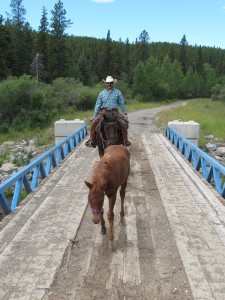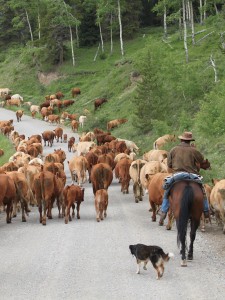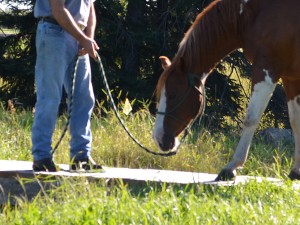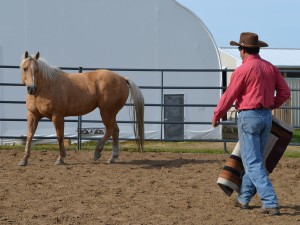In the horse world, the broad scope of leadership finds its way into training, clinics, and even rehabilitation and motivational programs for people. It has been the subject of books, and rightly so. In an attempt to keep this article shorter than a full length novel, I have tried to pick out a few ideas that might help you focus your approach to working with horses.
You have to be the leader! This is something we have either been told or instructed someone else.
But what does being a leader really mean?
The dictionary definition of leader: The person who leads or commands; a guiding or directing head. This doesn’t say anything about how one conducts themselves as a leader; it simply states that the leader is the authority figure making the decisions.
In the human world there are many types of leaders. The captain of a hockey team. Our Prime Minister for example. Some think he is great. Others don’t. So is he a good leader ? The answer is both subjective (personal opinion) and quantifiable (economic statistics). Thus leadership has a measurable component too; we can see the results a good leader can produce.
What then, makes a good leader? You can probably think of many things. A person that gets things done. A person that is good at organizing and delegating. A person who makes your workplace fun and productive at the same time. This person is a good motivator. Can you think of leaders in your circle? Most likely. Think of someone who is or was a great boss at a place you worked.
Why were they great?
What we find difficult in the horse world is defining our personal role as a leader. It is difficult because we are not horses; all of our comparisons and expectations are instinctively related to human beings. The horses reactions, learning ability and mental needs are so much different, however. Therefore our leadership style has to reflect that.

A good leader is someone people want to be around. They exude dynamic, positive and infectious energy. Be that person for your horse. I try to cultivate this thought in my horses mind: ? Oh, here comes Scott ! I want to be with him, because when I am, things are just GREAT! It’s much easier to be relaxed, open minded and try for someone you have respect for.
Without question, we have to be the leader in the relationship with our horse. The words team and partner are cozy words that people use to describe a good relationship with a horse. However those words imply that you and your horse share the same herd status. This isn’t, or rather, shouldn’t be the case. If it is, then your horse is always going to be testing you to see if he is above or below you in the herd; your relationship will lack clarity. If your response to those tests is unclear and wishy-washy, you’re lacking the framework and structure that you require before you can really make progress with your horse.
This simply means that your relationship with your horse must be clear and concise. It doesn’t mean you can’t be friends and have fun. I have heard people say things like this: If you’re going to be a leader you can’t love your horse. No buddies. I don’t believe that is the case. It certainly isn’t the case in a herd of horses; the herd leader has friends and plays like any other member. But when it’s time to draw the line, that line is very clearly defined. Just like being a parent, being a leader doesn’t mean you can’t have a dynamic and positive relationship.

Chip is a 4 year old that I have great fun playing with. We have played and goofed around since he was born. He derives a lot of benefit from that: curiosity, comfort, courage, try and knowing what success feels like.? Like a lead horse, I can play with him and still be the boss. And when he has got a halter or saddle on, he knows we are going to work. The tone is a little more assertive and we are both in a different frame of mind. Under saddle he is generally more calm and relaxed, which is perfect. As a leader, having the ability to create this mindset for him opens up the door to learning and possibility.
We have established that you are not on the same social level as your horse. You are the herd leader, and he is a follower. So what kind of leader do you want to be? Let’s look at some qualities of a good leader as they pertain to the horseman.
Positive and peaceful.
Depression, anger and frustration have no place in the training ring. If you are feeling any negative emotions and you can’t get yourself under control, then stay away from horses until you can. As a leader you need to communicate the positive. What would the people of a country would think if their president was caught on video saying something like, I think this whole country is going downhill! You can’t fake your mood with a horse. They communicate with emotion and will pick up on that right away.
Think of things that are mental stressors for a horse. Food. Fear of a predator. Competition or lack of clarity in the social order. I find visualization a great tool when I work with a horse. For example, to set a tone for training, I envision that we are under a dome. Inside that dome it’s a bright sunny day, there is lots of grass to eat, there are no predators around, and the herd is at peace because their leader is. Just like your horse can tell when you are nervous, he can tell when you are in a peaceful state of mind. Create a positive and peaceful space to work in with your horse.

Obviously some activities such as competitions or chasing a cow – may seem anything but peaceful. By peaceful, I don’t mean lazy or slow. I’m referring to a calm state of mind. This will allow you and your horse to focus clearly on the job at hand even if that is running barrels. It is no secret that successful athletes know how to manage anxiety and maintain concentration. Your horse will come to recognize you as a source of positive and peaceful, and this goes a long way to creating a mental framework where you will find success.
Recognize a Good Try.
Just like you, your horse is not always going to get it right the first time. He might not quite understand what you want –particularly when trying a new exercise and he will respond with an attempt at doing something. Don’t get frustrated or upset when his attempt is not 100% correct.
For example, if you are asking a horse to back up for the first time, think of how that motion occurs. First, he must shift his weight backwards. Then he must lift a leg. And so on. So if the best your horse can do initially is shifting his weight in response to your body, then stop and reward him. All horses know how to back up, they do it all the time. What you are teaching him is how to respond to you. He is learning to associate what you are asking with a movement. And when he gets it right, he needs to know that. Now you have something to build on because he knows what you are looking for. It’s a tiny building block, but it is a building block. In contrast, if you lock your forearms onto the reins and pull back, expecting a backup, you might get it, but I guarantee you will get resistance. And that is the last thing we want: to teach the horse to brace against us. We want to teach the horse to be soft and giving every time we put a feather weight on the reins. To do this you must recognize and reward on the TRY.
I recently had a conversation with someone who told me of a recent session he had with his horse, trying to get him to step up on a bridge. “He made me so mad! I couldn’t believe he wouldn’t do something so easy. He’s stepped up onto things before! Well, I tell you, we had one heck of a conversation and I finally got him up there.”

Unfortunately this is a common scenario. We expect the horse to be just like a person and do what we say. If we think it’s easy to step on a bridge, then surely, it must be easy for a horse! Think back to when you were in grade school. Lets say the teacher asked you to multiply 234 by 978 in your head. You’d either sit their dumbfounded or say, “I can’t!”. And lets say after your response, the teacher made you run 10 laps around the school. When you got back to your desk, sweating and a mental mess, she asked you the same question again. Still can’t come up with the answer? OK – another 10 laps around the school. Surely, by now, you should be able to figure it out.
What kind of leader would this teacher be?
Motivational and Inspiring.
If it seems that your horse just does not get it when you’re trying to ask him something, then minimize the difficulty of your request. Don’t fall into one of these traps:
i) Increasing the pressure in the hopes that he will understand. That is akin to raising your voice when speaking to someone that doesn’t understand English.
ii) Picking at him if he is not understanding, doesn’t repeat the same request in the same way over and over. Like people, horses learn by repetition; what are you teaching him if you repeatedly set the same exercise up for failure?
If your horse is struggling with something, then break that thing down into smaller pieces, make each one a success, and then build back up to the original exercise and be cognizant that this could take days or even weeks. But those successes will motivate your horse.
DO NOT punish your horse because his response to your request is something you perceive as wrong. This is called negative reinforcement and there are many reasons why it doesn’t work in the end. Being told that you are wrong all the time is neither good motivation nor inspiration. Be careful to use your hands only to support your horse’s movement, not to tell him, “Wrong, wrong, wrong…”
If you consider his actions an attitude issue, then you as a leader need to show him how each piece is an incentive to relax, focus and yield. Maybe the attitude you are getting is born out of your over-expectation for an action, mixed with your unclear presentation and a confused and frustrated horse (or trainer). Don’t go down that road. Inspire your horse by showing him the better way and the rewards he gets when he is on that path. Don’t make the common mistake of rewarding his success with a more complicated request.
Be positively energetic in your presentation to your horse. Feel proud – and let him know it – when he does something right. Set every situation up so that your horse has a very good chance to succeed.
Adaptable.
If you go into a training session with your horse and have a list of very specific things you want to accomplish, well, you might want to think again. Horses don’t work that way. Approach each training session knowing that the horse for a large part is going to dictate what YOU do in the training. I’m not saying that the horse should make the decisions for everything that happens. I am saying that you must be cognizant of where your horses mind is at all times and adapt your plan to fit.
If an exercise is not going well, don’t continue to force it, particularly if the outcome is increasingly negative. Instead change it to something you can succeed at and revisit the original exercise later. Work on a more elementary exercise that supports what you originally intended to do. Adapt yourself to the situation to get his mind (and yours!) back on a positive track. Let each session with your horse end in some sort of success for him.
If, at the end of your session, you have a tired, sweaty horse that looks like his mind has just been crushed and we have all seen this, then you haven’t been adapting to the responses from your horse, you have only been considering your personal goals. A leader prioritizes his followers, not himself.
I’ve seen a lot of horses with good riders; the horses might be dripping with sweat at the end of the session, but there is a gleam of life and pride in their eye that just says, Hey ! I did good!
That’s how you want to finish up.
Assertive.
In the horse world, assertive goes hand in hand with clarity. Clearly present to your horse what you’re asking, in a way that a horse can understand it. Assertive does not mean rough or demanding or mean. It simply means that you are clear about what you are asking, and ensure that you get a change of some sort. A change means that the horse has acknowledged your request. The change may not be 100% what you wanted, and you have to accept that. Always question yourself:
Why didn’t it work ?
Why did it work? ?
Did I present it incorrectly?
Is the horse ready for this step yet?

Being assertive often means using pressure with a horse. Pressure does not mean being spurred, whipped or hit. Pressure does not always mean ‘move away’. It can mean ‘come to me’ or ‘I want your attention’.
Pressure can be energy within you, it can be a light tap, it can be a click or a kiss. I often tend to smack my leg with the lead rope or rein to make a noise. I’m trying to get his attention, not cause him pain. Be aware of the level of pressure your horse requires and don’t use any more than absolutely necessary. If it doesn’t seem to be having the desired effect, switch it up, but don’t use the same pressure with increasing force.
Your goal is this: be clear in your presentation when you ask for something. Ask with your space and energy. The ultimate goal being that the pressure you require is less and less, because you are offering him the opportunity to get it right.
Trust, Faith and Commitment.
In order for you to be an effective leader, you must believe in what you are doing. If you don’t , your lack of commitment will be obvious to those you are leading. In the case of a horse, you must also trust in his ability and senses, and trust in your own abilities. Through time, the horse will learn to trust you to learn that you are the key to his success and a good mental place.
He’ll learn to trust your decisions.
You must have faith that you, and he, will succeed as difficult as the road may sometimes seem. Some days you might feel like you are not making any headway. Don’t let that get you down; end the session on a good note and try again tomorrow. Have faith that tomorrow will be a better day. Sometimes all it takes is for you and your horse to sleep on what you did.
A good leader openly displays commitment and can cultivate trust and faith in those that follow him.
Knowledgeable.
Leaders are knowledgeable people. They can use that knowledge to adapt when the situation changes, and understand why things do or don’t work. Knowledge comes with experience. The more we work at something, the more experience we get and the more knowledgeable we become. We all have resources to draw on: clinicians, experienced friends, trainers, instructional videos, books and articles online.
No single person knows everything about a horse. Recognizing the limitations of your knowledge and seeking out help and answers is a true leadership quality.

The other thing to realize here is that not all horses are the same. What worked with one horse may not work with another; you must accept that this is a fact. In those situations you have to try something different.m Ask for suggestions and be humble. If you are working with a horse, keep a journal of how things went. Spend some time analyzing why something did or didn’t work.
A good leader is always learning. A bad leader is someone who thinks they know more than they do. Even good clinicians take clinics and learn from others; they try different things and are always adapting and open to new methodologies.
Patience.
If there is one thing horses need way more than people do in the learning process, it’s time. They don’t learn the same way or at the same rate humans do. It’s worth the effort to spend the extra time and get it right.
If there is one thing that is hard for us all, it’s controlling frustration. You will get frustrated working with a horse. It can be like trying to speak English to someone that only understands Chinese. Frustration is guaranteed. How you deal with it is another thing entirely.
Teach yourself how to relax. Practice this on your own, away from your horse. Make this part of your life. If, in your non-horse activities, you let frustration get the best of you and act out in anger, or exude negative energy you WILL do this with your horse. It is simply how you have taught yourself to respond to pressure.
So change it. Anytime with or without horses you feel yourself become frustrated, cause yourself to relax. Think clearly and re-approach the situation with a positive attitude. Practicing this all the time, particularly away from horses – will lessen the odds that you will blow your top when you are around your horse. And don’t worry if it takes you a minute to relax, your horse is more than happy to do nothing for a minute. And during this minute you’re teaching him something vitally important: how his leader (you) reacts when things go wrong.
Good listener.
If you don’t think you need to listen, then your leadership style is dictatorship. There are many things that prevent us from being a good listener when we are with a horse. Things like personal goals, fear and ignorance.
When working on a particular exercise with your horse, be careful not to fall into the trap of focusing 100% on the result of what you are asking. This is an easy mistake to make, but it means that you’re not listening to him anymore. You have to be very open to feeling and noticing the subtle responses from him. Take in the big picture.
Fear causes us to become tense, and when we become this way, we are not able to feel anymore. Our minds become narrowly focused, our muscles tight. It’s not possible to be open to listening in that state.
Ignorance seems like a bad word, but all it really means is that we don’t know something. We can’t all know everything about a horse. However, we can theorize, practice and learn. And in our practicing and learning, we must be very aware of the horses response. This can be something as obvious as pinning ears or a swishing tail. It can be as subtle as feeling your horse tense a leg muscle or give ever so slightly when you pick up a rein. Learn what to expect.
Being a good listener with a horse involves much more than just visual input. You must be open to his emotional state, be relaxed enough with him that you sense the changes in the space and in his body. Again, this only comes with experience. A lot of it.
Accountability
This is a two way street. As a leader, you are ultimately responsible for your horses actions and your mutual success. Here is a way to put this in perspective for you. Instead of thinking, My horse isn’t good at this!, my horse always does this but I am asking for that ! Bad horse!
Consider rephrasing that and accepting the responsibility: I haven’t properly shown my horse this. Or My horse is having difficulty understanding my request. How can I change it up ? It’s a simply shift of thinking that just might cause you to open up some options you not have considered.
On the other side of the street is the fact that the horse has accountability too. If your horse is proficient at a movement, you have an expectation of the same. Hold him accountable for it. This doesn’t mean punishing him if he doesn’t do it. It does mean that if you set up the conditions for him to succeed at it, you should expect a good attempt. This is a fine balancing act that involves components of assertiveness, knowledge and judgement. Simply being more assertive may cause your horse to think, I really didn’t feel like trying there, but I see that Scott means business. I will give it a shot. Your expectations will also vary depending on the experience of the horse and his age. I would expect more out of a 15 year old seasoned ranch horse than a 3 year old.
Ultimately…
… you get out of horses what you put in. The amount of dedication and effort you put into that journey dictates how much of a horseman you are or can become. Good leaders ensure that there is something in it for the horse. Good leaders are always learning, always listening.

My horse Ty broke his neck over 4 years ago. Since that incident I have ridden him up mountains and worked cows on him. He and I would not have been able to accomplish that without exploring all of the qualities I have mentioned in this article, and of course a solid commitment to success however long it might take and through whatever obstacles might present themselves. I am currently working on a book about his life, our experiences together and all the people that have made such a positive influence. In the book I touch on how much he has taught me about compassion, listening, trust and faith, not to mention horse physiology. I am a different person because of Ty, and he a different horse because of me; we have improved each other’s lives immensely. In writing about that, I came up with this postulation that I’m using to focus my own approach to learning and horsemanship:
A true horseman, a true leader of horses – is a person who can show a horse how to be more of a horse, and at the same time, allow the horse to show him how to be more of a person.
Scott Phillips
September 2014
